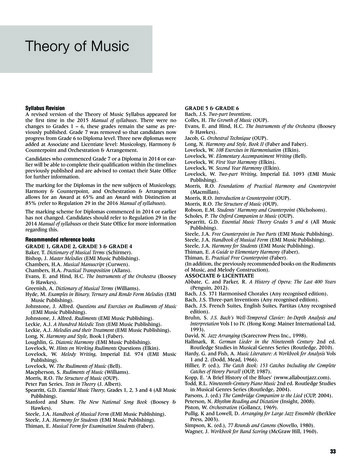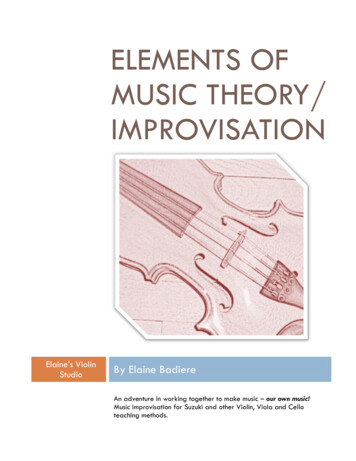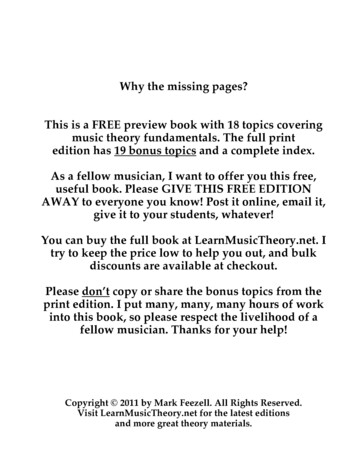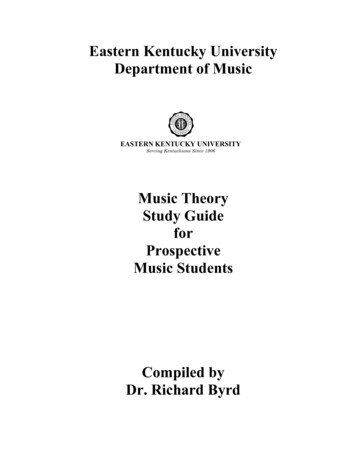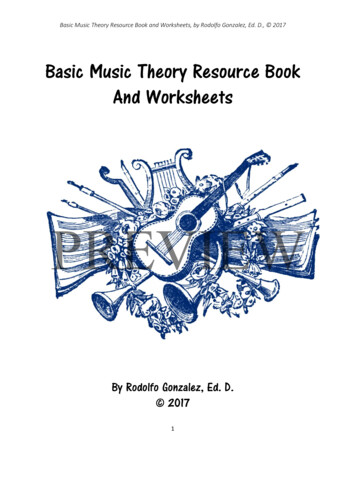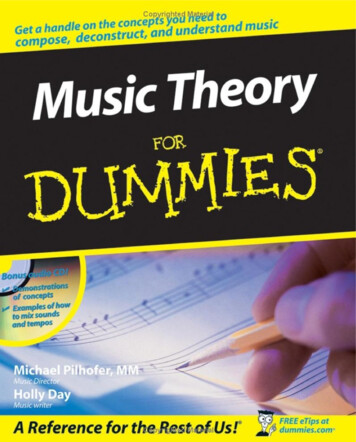
Transcription
Music TheoryFORDUMmIES‰by Michael Pilhofer and Holly Day
Music TheoryFORDUMmIES‰
Music TheoryFORDUMmIES‰by Michael Pilhofer and Holly Day
Music Theory For Dummies Published byWiley Publishing, Inc.111 River St.Hoboken, NJ 07030-5774www.wiley.comCopyright 2007 by Wiley Publishing, Inc., Indianapolis, IndianaPublished by Wiley Publishing, Inc., Indianapolis, IndianaPublished simultaneously in CanadaNo part of this publication may be reproduced, stored in a retrieval system, or transmitted in any form orby any means, electronic, mechanical, photocopying, recording, scanning, or otherwise, except as permittedunder Sections 107 or 108 of the 1976 United States Copyright Act, without either the prior written permission of the Publisher, or authorization through payment of the appropriate per-copy fee to the CopyrightClearance Center, 222 Rosewood Drive, Danvers, MA 01923, 978-750-8400, fax 978-646-8600. Requests tothe Publisher for permission should be addressed to the Legal Department, Wiley Publishing, Inc., 10475Crosspoint Blvd., Indianapolis, IN 46256, 317-572-3447, fax 317-572-4355, or online at http://www.wiley.com/go/permissions.Trademarks: Wiley, the Wiley Publishing logo, For Dummies, the Dummies Man logo, A Reference for theRest of Us!, The Dummies Way, Dummies Daily, The Fun and Easy Way, Dummies.com and related tradedress are trademarks or registered trademarks of John Wiley & Sons, Inc. and/or its affiliates in the UnitedStates and other countries, and may not be used without written permission. All other trademarks are theproperty of their respective owners. Wiley Publishing, Inc., is not associated with any product or vendormentioned in this book.LIMIT OF LIABILITY/DISCLAIMER OF WARRANTY: THE PUBLISHER AND THE AUTHOR MAKE NO REPRESENTATIONS OR WARRANTIES WITH RESPECT TO THE ACCURACY OR COMPLETENESS OF THECONTENTS OF THIS WORK AND SPECIFICALLY DISCLAIM ALL WARRANTIES, INCLUDING WITHOUTLIMITATION WARRANTIES OF FITNESS FOR A PARTICULAR PURPOSE. NO WARRANTY MAY BE CREATED OR EXTENDED BY SALES OR PROMOTIONAL MATERIALS. THE ADVICE AND STRATEGIES CONTAINED HEREIN MAY NOT BE SUITABLE FOR EVERY SITUATION. THIS WORK IS SOLD WITH THEUNDERSTANDING THAT THE PUBLISHER IS NOT ENGAGED IN RENDERING LEGAL, ACCOUNTING, OROTHER PROFESSIONAL SERVICES. IF PROFESSIONAL ASSISTANCE IS REQUIRED, THE SERVICES OF ACOMPETENT PROFESSIONAL PERSON SHOULD BE SOUGHT. NEITHER THE PUBLISHER NOR THEAUTHOR SHALL BE LIABLE FOR DAMAGES ARISING HEREFROM. THE FACT THAT AN ORGANIZATIONOR WEBSITE IS REFERRED TO IN THIS WORK AS A CITATION AND/OR A POTENTIAL SOURCE OF FURTHER INFORMATION DOES NOT MEAN THAT THE AUTHOR OR THE PUBLISHER ENDORSES THE INFORMATION THE ORGANIZATION OR WEBSITE MAY PROVIDE OR RECOMMENDATIONS IT MAY MAKE.FURTHER, READERS SHOULD BE AWARE THAT INTERNET WEBSITES LISTED IN THIS WORK MAY HAVECHANGED OR DISAPPEARED BETWEEN WHEN THIS WORK WAS WRITTEN AND WHEN IT IS READ.For general information on our other products and services, please contact our Customer CareDepartment within the U.S. at 800-762-2974, outside the U.S. at 317-572-3993, or fax 317-572-4002.For technical support, please visit www.wiley.com/techsupport.Wiley also publishes its books in a variety of electronic formats. Some content that appears in print maynot be available in electronic books.Library of Congress Control Number: 2007920019ISBN: 978-0-7645-7838-0Manufactured in the United States of America10 9 8 7 6 5 4 3 2 1
About the AuthorsMichael Pilhofer: Michael Pilhofer teaches music theory and percussion atMcNally Smith College of Music in St. Paul, Minnesota, where he serves asdepartment head of the Ensembles Department. He has worked as a professional musician for more than 18 years and has toured and recorded withJoe Lovano, Marian McPartland, Kenny Wheeler, Dave Holland, Bill Holman,Wycliffe Gordon, Peter Erskine, and Gene Bertoncini.Holly Day: Holly Day has written about music for numerous publicationsinternationally, including Computer Music Journal, ROCKRGRL, Music Alive!,Guitar One, Brutarian Magazine, Interface Technology, and Mixdown magazine.Over the past couple of decades, her writing has received an Isaac AsimovAward, a National Magazine Award, and two Midwest Writer’s Grants. Herprevious books include The Insider’s Guide to the Twin Cities (3rd, 4th, and5th Editions), Shakira, and Behind the Orange Curtain: A History of OrangeCounty Punk Rock.
DedicationTo Wolfegang and Astrid, with much love.Authors’ AcknowledgmentsSpecial acknowledgement goes to all the musicians and composers who tookthe time out of their very busy schedules to share their thoughts on writingmusic with us.Steve Reich, Philip Glass, Irmin Schmidt, Barry Adamson, Jonathan Segel,John Hughes III, Nick Currie, Andrew Bird, Fred Sokolow, Rachel Grimes,Christian Frederickson, Pan Sonic, Mark Mallman, Leslie Hermelin, CorbinCollins, and Matt Wagner: thank you.Special thanks goes to Tom Day, whose patience both in and out of theproduction booth is always amazing.R.I.P., Dr. Robert Moog.
Publisher’s AcknowledgmentsWe’re proud of this book; please send us your comments through our Dummies online registrationform located at www.dummies.com/register/.Some of the people who helped bring this book to market include the following:Acquisitions, Editorial, andMedia DevelopmentProject Editor: Corbin CollinsAcquisitions Editor: Stacy KennedyCopy Editor: Corbin CollinsTechnical Editor: Delbert BowersMedia Project Supervisor: Laura Moss-HollisterMedia Development Specialist: Kit MaloneComposition ServicesProject Coordinator: Patrick RedmondLayout and Graphics: Carl Byers,Joyce Haughey, Laura Pence,Heather Ryan, Rashell SmithSpecial Art: W.R. Music Service/Woytek andKrystyna RynczakAnniversary Logo Design: Richard PacificoEditorial Manager: Michelle HackerProofreaders: Aptara, Jessica Kramer,Susan Moritz, Todd LotheryEditorial Supervisor and Reprint Editor:Carmen KrikorianIndexer: AptaraEditorial Assistants: Erin Calligan Mooney,Joe Niesen, David Lutton, Leeann HarneyCartoons: Rich Tennant(www.the5thwave.com)Publishing and Editorial for Consumer DummiesDiane Graves Steele, Vice President and Publisher, Consumer DummiesJoyce Pepple, Acquisitions Director, Consumer DummiesKristin A. Cocks, Product Development Director, Consumer DummiesMichael Spring, Vice President and Publisher, TravelKelly Regan, Editorial Director, TravelPublishing for Technology DummiesAndy Cummings, Vice President and Publisher, Dummies Technology/General UserComposition ServicesGerry Fahey, Vice President of Production ServicesDebbie Stailey, Director of Composition Services
Contents at a GlanceIntroduction .1Part I: Rhythm: Keeping the Beat .7Chapter 1: What Is Music Theory Anyway? .9Chapter 2: Counting Out Notes.15Chapter 3: Giving It a Rest .31Chapter 4: Time Signatures .41Chapter 5: Naturalizing the Beat .57Chapter 6: Tempo and Dynamics .65Part II: Melody: The Part You Hum .77Chapter 7: The Musical Staff .79Chapter 8: Instrument Tone and Color .93Chapter 9: Half Steps, Whole Steps, Sharps, and Flats .99Part III: Harmony: Fleshing It Out .105Chapter 10: Intervals.107Chapter 11: Key Signatures and the Circle of Fifths.131Chapter 12: The Major and Minor Scales .147Chapter 13: Building Chords .161Chapter 14: Chord Progressions.193Chapter 15: Cadence .207Part IV: Form: How It’s Shaped.215Chapter 16: The Elements of Form.217Chapter 17: Classical Forms.229Chapter 18: Popular Forms .241Part V: The Part of Tens .249Chapter 19: Six Most Frequently Asked Questions About Music Theory .251Chapter 20: Ten Cool and Useful Resources .255Chapter 21: Nine Music Theorists You Should Know About .261
Appendix A: How to Use the CD .269Appendix B: Chord Chart .277Appendix C: Glossary .315Index .319
Table of ContentsIntroduction .1About This Book.1Whom This Book Is For .2The absolute beginner.2The music student who quit .2The experienced performer .2How This Book Is Organized.3Part I: Rhythm: Keeping the Beat .3Part II: Melody: The Part You Hum.3Part III: Harmony: Fleshing It Out .3Part IV: Form: How It’s Shaped .4Part V: The Part of Tens.4Icons Used in This Book.4Where to Go from Here.5Part I: Rhythm: Keeping the Beat.7Chapter 1: What Is Music Theory Anyway? . . . . . . . . . . . . . . . . . . . . . . .9How Will Theory Help My Music? .10The Old Lady and the Yardstick .10The Birth of Music and Theory .11The Greeks: First Theorists .12The Keyboard and Music Notation .12Chapter 2: Counting Out Notes . . . . . . . . . . . . . . . . . . . . . . . . . . . . . . . . .15Meet the Beat.15Notes and Note Values.16The big picture.16The way notes look .17Finding and following the beat .20Whole Notes.20Half Notes.22Quarter Notes .22Eighth Notes and Beyond.24Dotted and Tied Notes.25Dotted notes.26Tied notes.26Mixing It All Up .27
xiiMusic Theory For DummiesChapter 3: Giving It a Rest . . . . . . . . . . . . . . . . . . . . . . . . . . . . . . . . . . . . .31Whole Rests .32Half Rests .33Quarter Rests.34Eighth Rests and Beyond .35Dotted Rests .36Mixing It All Up .
Music Theory FOR DUMmIES‰ by Michael Pilhofer and Holly Day 01_578380 ffirs.qxp 2/27/07 1:46 PM Page iii


